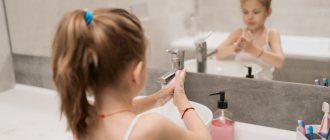Report “Physical education in preschool educational institutions and its significance”
Physical education in preschool educational institutions and its significance
Recently, health-saving technologies have been increasingly used in kindergartens. One of the directions of these technologies is the use in preschool institutions of methods to activate muscle tone and motor-coordinating systems. Physical education, as a form of active recreation during sedentary activities, is widely used with preschool children.
Physical education is physical exercise aimed at restoring children’s performance, improving their well-being, increasing attention, preventing fatigue, posture disorders, i.e. to improve the health of children's bodies. Complexes are exercises composed of different movements aimed at actively working various muscle groups and relaxing them; activation of attention, increased excitability of the nervous system, formation and strengthening of posture, as well as breathing. In addition to physical exercises, the complexes may include elements of massage, finger and breathing exercises, and eye exercises.
The purpose of a physical education session (dynamic pause) is to increase or maintain mental performance during direct educational activities, prevent fatigue, and provide short-term active rest for children when the organs of vision and hearing experience significant stress; muscles of the trunk, especially the back, which are in a static state; muscles of the working hand.
Physical education allows educators and teachers, as well as parents, to play with children, make them happy and, at the same time, develop speech, coordination and fine motor skills. In the process of performing physical exercises, blood circulation improves, areas of the cerebral cortex that were not involved in previous activity are excited, and those that did are inhibited. In this regard, fatigue of the muscles and nervous system is relieved, and children experience positive emotions and improve their mood.
Raising children to be physically perfect means ensuring that they are healthy and hardened from an early age.
To solve problems and improve the health of preschool children, various means of physical education are used, including physical education sessions. The integrated use of all means (hygienic factors, natural forces, physical exercise and others) effectively affects the child’s body.
Physical education is a small set of physical exercises performed for 2-3 minutes during classes in kindergarten, as well as at home when doing homework. It is built from 4-5 exercises for the arms, torso, and legs that do not require complex coordination.
A set of exercises for physical education minutes; methodological development on physical education on the topic
SET OF EXERCISES FOR PHYSICAL ACTIVITIES
Physical education teacher A.T. Firsova
EXERCISES TO IMPROVE CEREBRAL CIRCULATION
- Starting position (i.p.) – sitting on a chair. 1 – tilt your head to the right; 2 – i. P.; 3 – tilt your head to the left; 4 – i. P.; 5 – tilt your head forward, do not raise your shoulders; 6 – i. p. Repeat 3-4 times. The pace is slow.
- I. p. - sitting, hands on the belt. 1 – turn the head to the right; 2 – i. P.; 3 – turn the head to the left; 4 – i. p. Repeat 4-5 times. The pace is slow.
EXERCISES TO REMOVE FATIGUE FROM THE SHOULDER GIRLE AND ARMS
- I. p. - standing, hands on the belt. 1 – right hand forward, left up; 2 – change the position of your hands. Repeat 3-4 times, then relax down and shake your hands, tilt your head forward. Then repeat 3-4 more times. The pace is average.
- I. p. - standing or sitting, with the back of the hands on the belt. 1–2 – bring your elbows forward, tilt your head forward; 3–4 – elbows back, bend over. Repeat 5-6 times, then arms down and shake them relaxed. The pace is slow.
- I. p. - sitting, hands up. 1 – clench your hands into a fist; 2 – unclench your hands. Repeat 6-8 times, then relax your arms down and shake your hands. The pace is average.
EXERCISES TO RELEASE TENSION FROM THE TORSO MUSCLES
- I. p. - sitting, hands up. 1 – clench your hands into a fist; 2 – unclench your hands. Repeat 6-8 times, then relax your arms down and shake your hands. The pace is average.
EXERCISES TO RELEASE TENSION FROM THE TORSO MUSCLES
- I. p. - stand, legs apart, hands behind the head. 1–3 – circular movements of the body in one direction; 4–6 – the same in the other direction; 7–8 – arms down and shake your hands in a relaxed manner. Repeat 4-6 times. The pace is average.
- I. p. - stand with legs apart. 1–2 – tilt to the side, the right hand slides down along the leg, the bent left hand slides up along the body; 3–4 – i. P.; 5–8 – the same in the other direction. Repeat 5-6 times. The pace is average.
EXERCISES FOR SCHOOLCHILDREN IN CLASSES WITH ELEMENTS OF WRITING
- Exercises to improve cerebral circulation. I. p. - sitting, hands on the belt. 1 – turn the head to the right; 2 – i. P.; 3 – turn the head to the left; 4 – i. P.; 5 – tilt your head forward; 6 – i. p. Repeat 4-6 times. The pace is slow.
- Exercises to relieve fatigue from the small muscles of the hand. I. p. - sitting, arms raised up. 1 – clench your hands into a fist; 2 – unclench your hands. Repeat 6-8 times, then relax your arms down and shake your hands. The pace is average.
- Exercise to relieve fatigue from the muscles of the torso. I. p. - stand, legs apart, hands on the belt. 1 – turn the body to the right; 2 – turn your torso to the left. During the turn, the legs remain motionless. Repeat 4-6 times. The pace is average.
- Exercise to mobilize attention. I. p. - standing, arms along the body. 1 – right hand on the belt; 2 – left hand on the belt; 3 – right hand on the shoulder; 4 – left hand on the shoulder; 5 – right hand up; 6 – left hand up; 7–8 – clapping hands above the head; 9 – lower your left hand to your shoulder; 10 – right hand on the shoulder; 11 – left hand on the belt; 12 – right hand on the belt; 13–14 – clap hands on thighs. Repeat 4-6 times. Tempo – 1 time slow; 2–3 times – average; 3–4 – fast; 1–2 – slow.
Let's give a few more examples of exercises that help avoid fatigue and restore strength in class. They are quite simple and effective, they do not require special equipment, and therefore they can be performed in the classroom as part of a physical education program.
EYE EXERCISES
Headaches are often caused by overwork or unusual strain on the eyes. This exercise is the simplest and should develop the habit of doing eye exercises regularly.
- Open your eyes wide. Look up as far as you can, hold your gaze for one second. Then move your eyes all the way to the right, fixing this position for a second. Next - eyes all the way down, fixing for a second, and then all the way to the left, also fixing for a second. Keep your eyes wide open. Perform the exercise 10 times clockwise and the same number of times counterclockwise.
After completing the exercise, it is useful to remind schoolchildren: for eye care, it is very important that the workplace is well and properly lit. Avoid glare. It is useful to stop working several times an hour for a few seconds and give your eyes a rest, that is, cover them with your palms so that they rest in complete darkness.
Squatting exercise makes the heart work easier and lowers blood pressure. It’s simple to do: squat down freely (your foot is completely on the floor), relax as much as possible, holding your head and arms up. Sit in this position for one minute. Exercises to relieve fatigue should be performed at the first signs of distress and fatigue.
- Place your palms in front of your chest, fingers up, do not breathe, and squeeze the bases of your palms with all your might. The muscles of the shoulders and chest are tense. Pull your stomach in and rise up, as if leaning on your hands and looking out of the window. Just 10-15 seconds - and it became hot. Repeat three times.
- Clasp your hands, clasp the back of your head, point your elbows forward. Pull your head towards your elbows, do not resist, stretch the cervical spine. Pull evenly - so that it is pleasant, 10-15 seconds.
- Rub your ears with your palms - first only the lobes, and then the entire ear: up and down, back and forth. At the same time, click your tongue like a horse (15–20 seconds).
- "Crow". Pronounce “ka-aa-aa-aar”, while trying to raise the soft palate and small tongue as high as possible (6 times). Then try to do it silently, with your mouth closed.
- "Ring". With effort, directing the tip of your tongue back along the upper palate, try to touch the small uvula with your tongue. Try to do this silently, with your mouth closed. Easier, faster, even faster! (10–15 seconds.)
- "A lion". Reach your tongue to your chin. Even further! (Repeat 6 times).
Basic requirements for the selection and conduct of physical education sessions.
“The physical education of a child is the basis for everything else. Without the correct use of hygiene in the development of a child, without properly organized physical education and sports, we will never get a healthy generation.”
A. V. Lunacharsky
Basic requirements for the selection and conduct of physical education sessions.
Learning activities in the classroom, like any activity, can cause a decrease in the functional capabilities of the body, a feeling of fatigue, indicating the need for rest for the student’s body. Alternating between different types of activities as fatigue develops helps relieve muscle and mental tension, activate mental activity and increase learning efficiency. Integration of educational, motor and gaming activities when organizing the educational process increases mental performance in children and improves the emotional background.
Physical education minutes
- short-term physical exercises - carried out during breaks between classes, as well as during classes that require intellectual stress (speech development, drawing, mathematics, etc.).
The purpose of the physical education minute
— to increase or maintain children’s mental performance in classes, to provide short-term active rest during classes, when the organs of vision and hearing experience significant stress; muscles of the trunk, especially the back, which are in a static state; muscles of the working hand.
Often a child exhibits “motor restlessness” during classes. He tries to change his position, his attention drops, he gets distracted. This indicates mental fatigue, which is recognized primarily by decreased attention. As a result of prolonged static tension, the child’s back slouches, shoulders droop, blood circulation slows down, which leads to poor posture, negatively affects the functioning of the vital functions of the body, and ultimately negatively affects health.
The objectives of
the physical education minute are:
- to reduce fatigue and remove the negative effects of a monotonous forced position at a desk;
-relieve neuropsychic stress in students by switching to another type of activity;
- to activate students’ attention and increase their ability to perceive educational material;
-increase schoolchildren’s interest in physical exercise;
-expand your understanding of the impact of physical exercise on well-being;
- to develop knowledge, skills and abilities to independently perform physical exercises.
Physical education sessions have a positive effect on brain activity, activate the cardiovascular and respiratory systems, improve blood supply to internal organs and the performance of the nervous system. The start time of physical education is determined by the teacher himself, taking into account the content of educational activities in the lesson when signs of fatigue appear. The physiologically reasonable time for physical education is the 15th - 20th minute of the lesson, especially in lessons 4, 5, 6. In the first grade, it is recommended to conduct two physical education minutes in each lesson, at 10-15 and 25-30 minutes. In grades 2–4, it is recommended to conduct one physical education lesson each, starting from the 2nd or 3rd lesson due to the development of the first phase of mental fatigue in a significant part of the students in the class.
There are the following types of physical education minutes::
- Physical education session of general impact.
- Physical education to improve cerebral circulation.
- Exercise minutes to relieve fatigue from the shoulder girdle and arms.
- Physical exercises to relieve fatigue from the torso and legs.
- Physical exercises to relieve fatigue from the hands.
- Physical training sessions to relieve fatigue of the visual and auditory analyzers.
Requirements for conducting physical education sessions:
— Physical education sessions should be carried out at the initial stage of fatigue.
— Complexes are selected depending on the type of lesson and its content.
— Exercises should be varied and changed every 2 weeks.
-It is necessary to vary the forms of physical education sessions (sets of general developmental exercises, game tasks, simple low-intensity games, dance exercises to music, etc.).
- Use visual methods.
-Provide a positive emotional attitude.
-Observe ventilation.
Application
Physical education lessons in verse.
- Three bears walked home (step in place)
Dad was big - big (raise your hands up),
Mom is a little shorter (arms at chest level),
And my son is a little baby, just (sit down).
He was very small (crouching, swaying like a bear),
Walked with rattles (standing, imitating playing with rattles)
- Here is my turtle, She lives under her shell (we clench our fingers into a fist) She loves her home very much. When she wants to eat (extend her thumb), She sticks her head out. When she wants to sleep, or she is in danger (we hide her thumb in her fist), She hides her head.
- Two claps above your head, two claps in front of you,
Let's hide our two hands behind our backs and jump on two legs.
Exercise to improve cerebral circulation
1. Starting position (ip.) - sitting on a chair, 1-2 - smoothly tilt your head back, 3-4 - tilt your head forward, do not raise your shoulders. Repeat 4-6 times. The pace is slow.
2. I.p. - sitting, hands on the belt. 1 - turn the head to the right, 2 - i.p., 3 - turn the head to the left, 4 - i.p. Repeat 6-8 times. The pace is slow.
3. I.p. - standing or sitting, hands on the belt. 1 - swing your left hand over your right shoulder, turn your head to the left, 2 - IP, 3-4 - do the same with your right hand. Repeat 4-6 times. The pace is slow.
Physical education to relieve fatigue from the shoulder girdle and arms
1. I.p. - standing or sitting, hands on the belt. 1 - right hand forward, left up, 2 - change hand positions. Repeat 3-4 times, then relax down and shake your hands, tilt your head forward. The pace is average.
2. I.p. - standing or sitting, with the back of your hands on your belt. 1-2 - bring your elbows forward, tilt your head forward, 3-4 - elbows back, bend over. Repeat 6-8 times, then hands down and shake relaxed. The pace is slow.
3. I.p. - sitting, hands up. 1 - clench your hands into a fist, 2 - unclench your hands. Repeat 6-8 times, then relax your arms down and shake your hands. The pace is average.
4. I.p. - stand with your feet apart, hands behind your head. 1 - sharply turn the pelvis to the right, 2 - sharply turn the pelvis to the left. During turns, leave the shoulder girdle motionless. Repeat 6-8 times. The pace is average.
5. I.p. - stand with your feet apart, hands behind your head. 1-3 - circular movements of the pelvis in one direction, 4-6 - the same in the other direction, 7-8 - arms down and shake your hands in a relaxed manner. The pace is average.
6. I.p. - stand with legs apart. 1-2 - bend forward, the right hand slides down along the leg, the left, bending, along the body up, 3-4 - IP, 5-8 - the same in the other direction. Repeat 6-8 times. The pace is average.
A set of gymnastics exercises for the eyes
1. Blink quickly, close your eyes and sit quietly, slowly counting to 5. Repeat 4-5 times.
2. Close your eyes tightly (count to 3), open them, look into the distance (count to 5). Repeat 4-5 times.
3. Extend your right arm forward. Follow with your eyes, without turning your head, the slow movements of the index finger of your outstretched hand to the left and right, up and down. Repeat 4-5 times.
4. Look at the index finger of your outstretched hand for the count of 1-4, then move your gaze into the distance for the count of 1-6. Repeat 4-5 times.
5. At an average pace, make 3-4 circular movements with your eyes to the right side, and the same amount to the left side. Relax your eye muscles and look into the distance while counting 1-6. Repeat 1-2 times.
A set of exercises to relieve fatigue from the torso and legs.
1. I.p. — o.s. 1 - lunge to the left, arms arcing inward, upward to the sides. 2 - push your left leg, arching your arm downwards. 3-4 - the same in the other direction. Repeat 6-8 times. The pace is average.
2. I.p. — o.s. 1-2 - squat on toes, knees apart, arms forward - to the sides. 3 - stand on the right, swing the left back, arms up. 4 - place your left hand, hands freely down and shake your hands. 5-8 with a swing of the right leg back. Repeat 4-6 times. The pace is average.
3. I.p. - stand with legs apart. 1-2 - lean forward, the right hand slides down along the leg, the left hand, bending, slides up along the body. 3-4 - i.p. 5-8 in the other direction. Repeat 6-8 times. The pace is average.
Literature
1.Internet resources.
2. Isaeva S. A. Physical education minutes in elementary school Moscow: ed. Iris Press, 2003.









